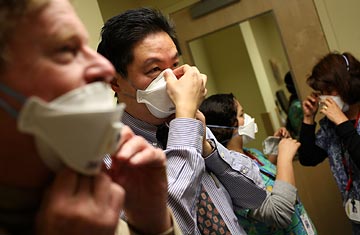
Swine flu, recently renamed H1N1 virus, is causing a swoon in pork prices. The Lean Hogs futures contract, traded on the Chicago Mercantile Exchange (CME), is down more than 10% since news of the potentially imminent pandemic first broke. The CME's Frozen Pork Bellies futures contract has suffered comparable losses.
At first glance, one might assume that a swine flu scare would send prices up, as pigs are widely slaughtered and supply disappears. Egypt, for instance, has begun slaughtering more than 300,000 presumably healthy pigs as a precautionary measure. However, the futures market is pricing hogs as if the fall in demand will outpace the drop in supply. (Read "Swine Flu: Don't Blame the Pig.")
Fear and panic have gripped both traders and consumers, even though the Centers for Disease Control and Prevention and the World Health Organization have clearly stated that there is no evidence of contamination in raw or cooked meat. Although the genetic makeup of the H1N1 virus originated in pigs, the flu itself was not directly transmitted from pigs to humans. Ironically, there is at least one documented case of it going the other way: the flu has been transmitted from a man to a herd of pigs in Canada. But almost all transmission is human-to-human.
Yet the threat of this new influenza strain has apparently frightened consumers away from buying pork, frightened traders into selling hog futures, and frightened entire countries, such as Russia and China, into slamming their doors to pork imports from Mexico and the U.S. Also, with prices falling, there is a bit of a self-fulfilling prophecy: as prices fall, food processors that buy hogs cut back on their orders because they believe they can buy hogs at even cheaper prices later on. The result: prices keep falling.
The Lean Hogs futures market on the CME is certainly the most liquid and transparent market related to the pork industry, but it can be buffeted by things other than the demand for pork. As hog prices fall, for instance, producers might take on short positions as a hedge, essentially locking in a price for their pigs before the market collapses even further. By taking on that short position, though, they are adding to the downward pressure on hog prices.
Similarly, speculators play their own self-protection game, which can add to bearish momentum. As markets tumble, the crash becomes exacerbated by traders' stop-loss orders, which automatically initiate more selling as the price falls. In other words, as traders who had bought hog contracts at a higher price begin to lose money on their long positions, they are forced to sell them before their losses escalate. (See the top five swine flu don'ts.)
The fall in prices, no matter the cause, could be devastating for the pork industry and ultimately bad for consumers. According to Dave Ward and Perry Iverson of Commodity and Ingredient Hedging, LLC, a Chicago-based agricultural-risk-management consulting firm, if prices continue to fall over the coming weeks, there will be fewer pork producers next year — and less pork production, consequently. Assuming demand for pork recovers, this will lead to higher prices long-term.
Hog producers have already suffered tight margins for the past two years, according to Ward and Iverson. The price of feed skyrocketed amid a rally in the prices of agricultural products, up until the recent slump in demand for pork. For example, soybeans recently set their seven-month high in futures trading on the Chicago Board of Trade.
This year, farmers will likely suffer heavy losses, as the sale price of their hogs does not meet the cost of raising the animals. The recent price fall could be realized as a $10 to $20 per head loss in the next 12 months, predict Ward and Iverson. Pork processors have already lowered their bids for pigs, given the great degree of uncertainty in predicting the demand for pork.
The situation is frustrating for pig producers: the fall in pork prices has nothing to do with meat contamination and everything to do with the phrase "swine flu." It is pure psychology.
